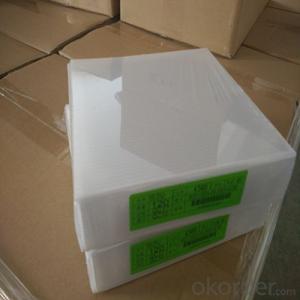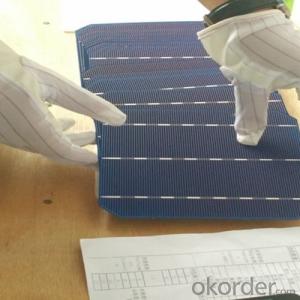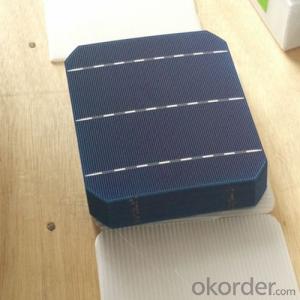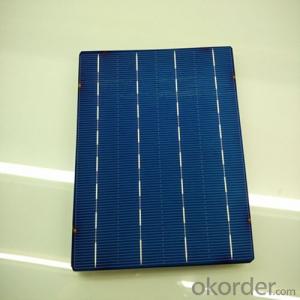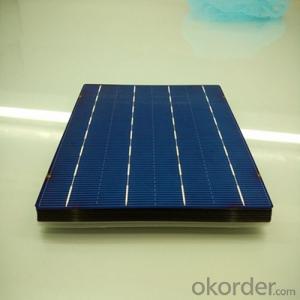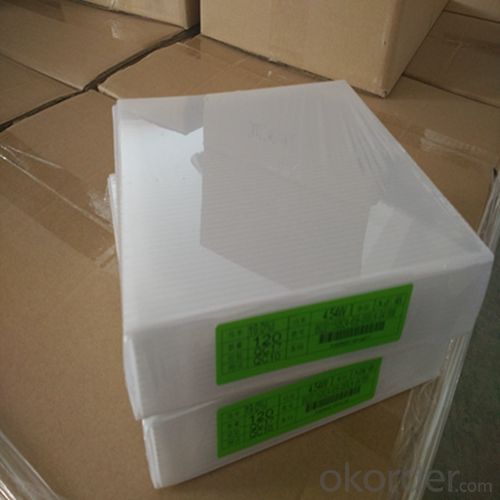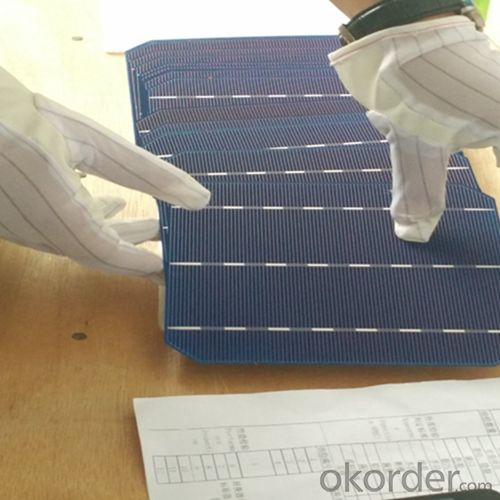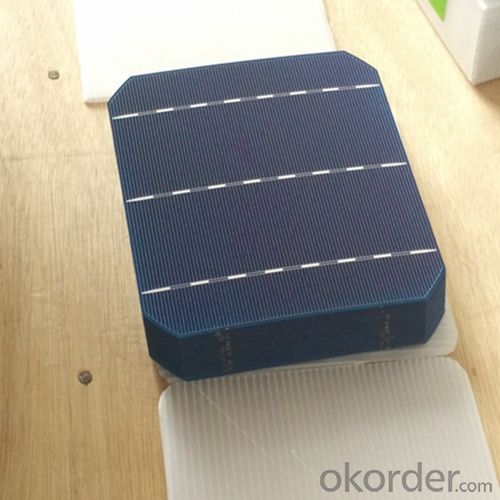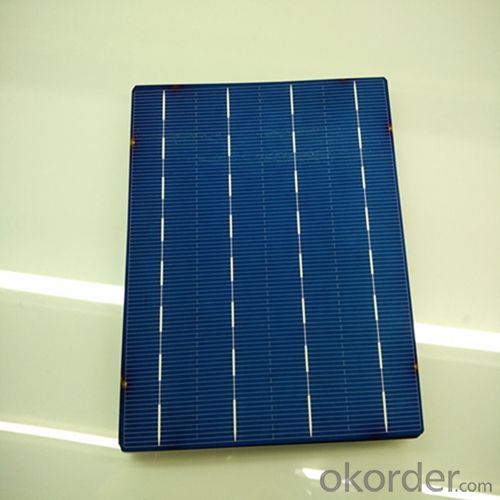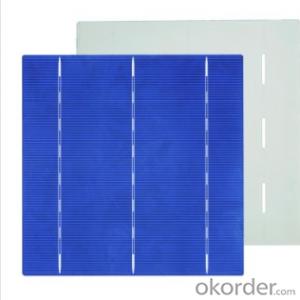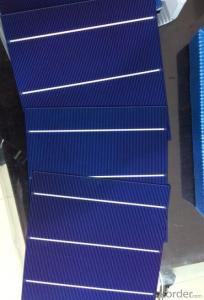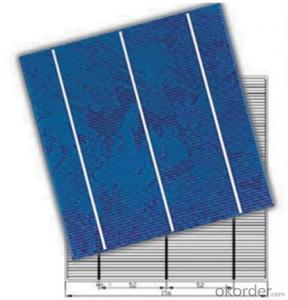Interdigitated Back Contact Solar Cells - Poly 156x156mm2 Grade 1 Made in China
- Loading Port:
- Shanghai
- Payment Terms:
- TT OR LC
- Min Order Qty:
- 6500 watt
- Supply Capability:
- 6000000 watt/month
OKorder Service Pledge
OKorder Financial Service
You Might Also Like
The operation of a photovoltaic (PV) cell requires 3 basic attributes:
The absorption of light, generating either electron-hole pairs or excitons.
The separation of charge carriers of opposite types.
The separate extraction of those carriers to an external circuit.
In contrast, a solar thermal collector supplies heat by absorbing sunlight, for the purpose of either direct heating or indirect electrical power generation from heat. A "photoelectrolytic cell" (photoelectrochemical cell), on the other hand, refers either to a type of photovoltaic cell (like that developed by Edmond Becquerel and modern dye-sensitized solar cells), or to a device that splits water directly into hydrogen and oxygen using only solar illumination.Characteristic of Mono 156X156MM2 Solar Cells
You are gaining energy independence - add battery backup power for even greater energy security
The cost of electricity is only going to rise – insure against that rising cost
Adaptive cells change their absorption/reflection characteristics depending to respond to environmental conditions. An adaptive material responds to the intensity and angle of incident light. At the part of the cell where the light is most intense, the cell surface changes from reflective to adaptive, allowing the light to penetrate the cell. The other parts of the cell remain reflective increasing the retention of the absorbed light within the cell.[67]
In 2014 a system that combined an adaptive surface with a glass substrate that redirect the absorbed to a light absorber on the edges of the sheet. The system also included an array of fixed lenses/mirrors to concentrate light onto the adaptive surface. As the day continues, the concentrated light moves along the surface of the cell. That surface switches from reflective to adaptive when the light is most concentrated and back to reflective after the light moves along
Mechanical data and design
Format | 156mm x 156mm±0.5mm |
Thickness | 210μm±40μm |
Front(-) | 1.5mm bus bar (silver),blue anti-reflection coating (silicon nitride) |
Back (+) | 2.5mm wide soldering pads (sliver) back surface field (aluminium) |
Temperature Coefficient of Cells
Voc. Temp.coef.%/K | -0.35% |
Isc. Temp.coef .%/K | +0.024%/K |
Pm.Temp.coef. %/K | -0.47%/K |
Electrical Characteristic
Effiency(%) | Pmpp(W) | Umpp(V) | Impp(A) | Uoc(V) | Isc(A) | FF(%) |
18.35 | 4.384 | 0.526 | 8.333 | 0.63 | 8.877 | 78.39% |
18.20 | 4.349 | 0.526 | 8.263 | 0.63 | 8.789 | 78.54% |
18.05 | 4.313 | 0.525 | 8.216 | 0.63 | 8.741 | 78.32% |
17.90 | 4.277 | 0.524 | 8.161 | 0.625 | 8.713 | 78.04% |
17.75 | 4.241 | 0.523 | 8.116 | 0.625 | 8.678 | 77.70% |
17.60 | 4.206 | 0.521 | 8.073 | 0.625 | 8.657 | 77.36% |
17.45 | 4.170 | 0.519 | 8.039 | 0.625 | 8.633 | 76.92% |
17.30 | 4.134 | 0.517 | 8.004 | 0.625 | 8.622 | 76.59% |
17.15 | 4.096 | 0.516 | 7.938 | 0.625 | 8.537 | 76.80% |
17.00 | 4.062 | 0.512 | 7.933 | 0.625 | 8.531 | 76.18% |
16.75 | 4.002 | 0.511 | 7.828 | 0.625 | 8.499 | 75.34% |
16.50 | 3.940 | 0.510 | 7.731 | 0.625 | 8.484 | 74.36% |
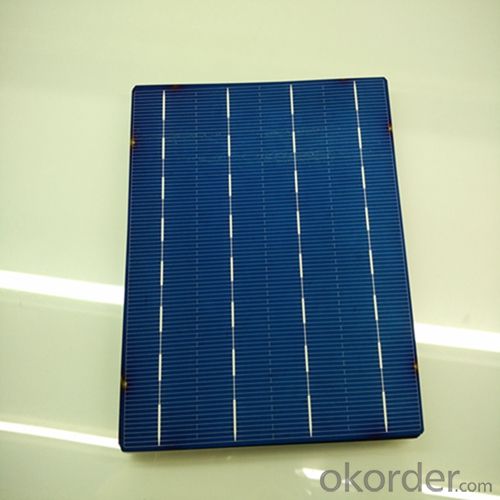
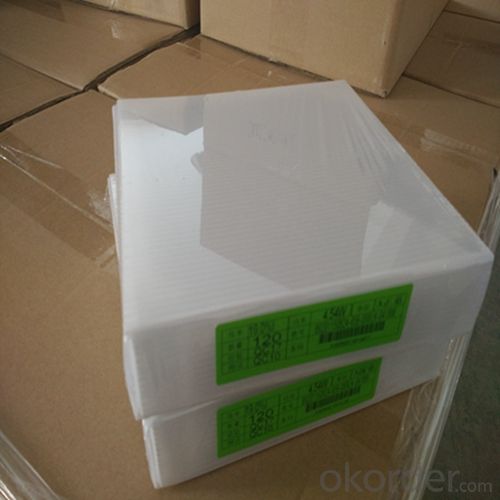
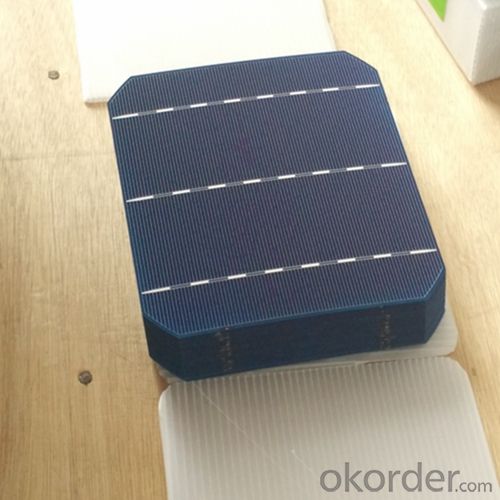
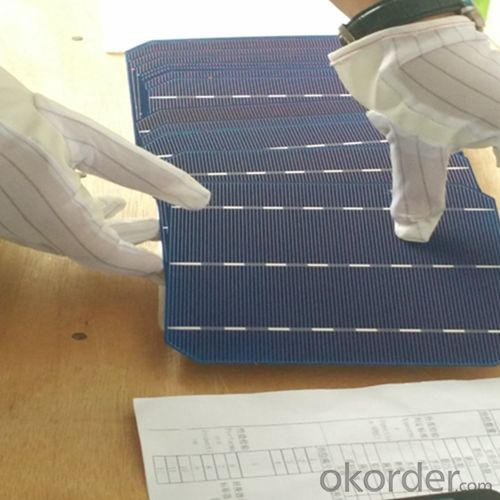
 FAQ
FAQ
Q: What price for each watt?
A: It depends on the quantity, delivery date and payment terms, generally Large Quantity and Low Price
Q: What is your size for each module? Can you tell me the Parameter of your module?
A: We have different series of panels in different output, both c-Si and a-Si. Please take the specification sheet for your reference.
Q: What is your size for each module? Can you tell me the Parameter of your module?
A: We have different series of panels in different output, both c-Si and a-Si. Please take the specification sheet for your reference.
- Q: How can I explain to my 10 year old daughter what solar cells are?
- Solar cells are the cell that can collect the solar energy from nature.
- Q: How do solar cells perform in regions with frequent thunderstorms?
- Solar cells perform less efficiently in regions with frequent thunderstorms. Thunderstorms often bring heavy cloud cover and reduced sunlight, which significantly impacts the generation of solar energy. Additionally, the presence of lightning poses a risk to the solar panels themselves, potentially damaging or destroying them. Therefore, regions with frequent thunderstorms may not be ideal for solar energy production.
- Q: How do solar cells perform in areas with limited space for installation?
- Solar cells can still perform effectively in areas with limited space for installation by utilizing innovative technologies such as rooftop solar panels, vertical solar panels, or solar panels integrated into building materials. These compact and space-efficient designs allow for the generation of solar energy even in tight spaces, making it possible to harness the benefits of solar power without requiring vast expanses of land.
- Q: Can solar cells be used for aerospace applications?
- Yes, solar cells can be used for aerospace applications. They are commonly used in satellites and spacecraft to generate electrical power from sunlight. Solar cells are lightweight, reliable, and efficient, making them ideal for powering various systems and instruments in space missions.
- Q: What is the impact of shading on solar cell performance?
- Shading has a significant negative impact on solar cell performance. When a solar cell is partially shaded, it reduces the amount of sunlight reaching the shaded area, leading to a decrease in power generation. This is because shading disrupts the flow of electrical current within the solar cell, resulting in reduced efficiency and overall output. Even a small amount of shading, such as from trees, buildings, or debris, can have a noticeable impact on the performance of the solar cell. Therefore, it is important to carefully consider the placement and positioning of solar panels to avoid shading and maximize their efficiency.
- Q: Can solar cells be used to power parking meters?
- Yes, solar cells can be used to power parking meters. They can efficiently convert sunlight into electricity, providing a sustainable and reliable source of power for parking meters without the need for continuous grid connection or batteries.
- Q: Silicon solar cell power generation principle
- When the junction of two different materials formed by the light irradiation, the process of generating electromotive force.The process of the first material absorbs the energy of the photon, resulting in equal number of positive and negative charge, then these charges were migrated to both sides of the knot, The formation of even electricity layer. Although the effect is not generated instantaneous, but the response time is quite short.
- Q: How do solar cells perform in areas with high humidity and saltwater exposure?
- Solar cells can still perform well in areas with high humidity and saltwater exposure, although their efficiency may be slightly reduced. The moisture in the air and the saltwater can create a thin layer of corrosion on the surface of the solar cells, which can hinder their performance over time. However, advancements in solar cell technology, such as improved coatings and materials, have made them more resilient to these conditions. Regular cleaning and maintenance can also help mitigate the effects of humidity and saltwater exposure on solar cell performance.
- Q: Can solar cells be used in marine applications?
- Yes, solar cells can be used in marine applications. They can be integrated into boats, yachts, and other marine vessels to generate electricity from sunlight, which can be used to power various onboard systems and equipment. Additionally, solar cells can also be used to charge batteries, providing a reliable and sustainable source of energy for marine applications.
- Q: How do solar cells impact global warming?
- Solar cells have a positive impact on global warming as they generate clean, renewable energy by converting sunlight into electricity, reducing the reliance on fossil fuels. By utilizing solar cells, we can decrease greenhouse gas emissions and mitigate climate change.
Send your message to us
Interdigitated Back Contact Solar Cells - Poly 156x156mm2 Grade 1 Made in China
- Loading Port:
- Shanghai
- Payment Terms:
- TT OR LC
- Min Order Qty:
- 6500 watt
- Supply Capability:
- 6000000 watt/month
OKorder Service Pledge
OKorder Financial Service
Similar products
Hot products
Hot Searches
Related keywords
